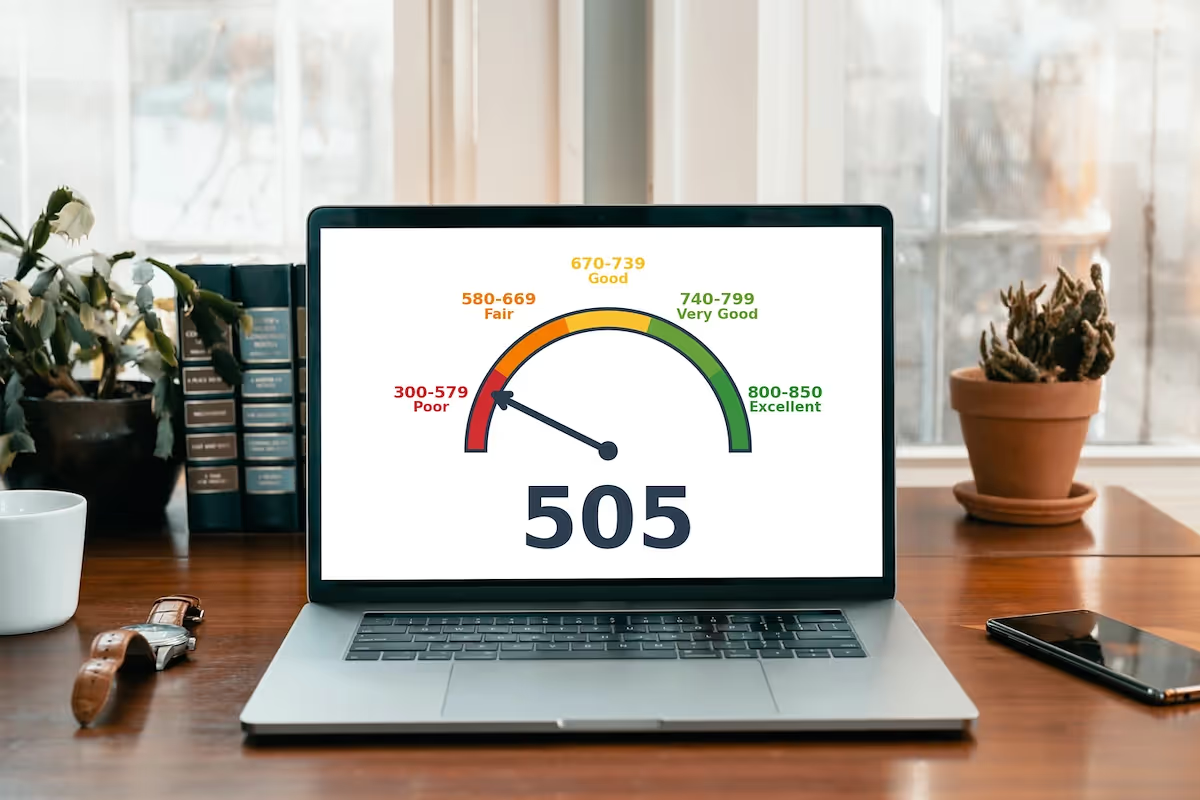
Kudos has partnered with CardRatings and Red Ventures for our coverage of credit card products. Kudos, CardRatings, and Red Ventures may receive a commission from card issuers. Kudos may receive commission from card issuers. Some of the card offers that appear on Kudos are from advertisers and may impact how and where card products appear on the site. Kudos tries to include as many card companies and offers as we are aware of, including offers from issuers that don't pay us, but we may not cover all card companies or all available card offers. You don't have to use our links, but we're grateful when you do!
505 Credit score: What You Need to Know in 2025
July 1, 2025


TL;DR
A 505 credit score presents a clear opportunity for financial growth, offering a solid foundation to build upon. Under the FICO scoring model, this score is considered to be in the 'Poor' credit range.
What Does a 505 Credit Score Mean?
A 505 credit score places you in the "poor" range of the FICO scoring model, which spans from 300 to 850. Lenders view scores in this category (typically 300-579) as a sign of high risk, often stemming from a history of missed payments, high credit card balances, or other negative financial events. This number essentially tells potential creditors that you've had significant trouble managing credit in the past.
Financially, this score can create major hurdles. You may find it difficult to get approved for new loans or credit cards. If you are approved, it will likely be with very high interest rates and less-than-ideal terms, making borrowing much more expensive. While this can feel discouraging, a credit score is not set in stone. Understanding where you stand is the first step toward improving your financial outlook.
Who Has a 505 Credit Score?
While age is not a direct factor in credit score calculations, there is a clear correlation between age and average credit scores. Data shows that scores tend to improve as people get older, largely because they have had more time to build a positive payment history and manage different types of credit. According to a 2023 generational breakdown from Experian, here is the average FICO score for each age group:
- Generation Z (ages 18-26): 680
- Millennials (ages 27-42): 690
- Generation X (ages 43-58): 709
- Baby Boomers (ages 59-77): 745
- Silent Generation (ages 78+): 760
Credit Cards With a 505 Credit Score
A credit score of 505 falls into the "poor" range, which can significantly challenge your ability to get approved for a traditional credit card. Most lenders view this score as an indicator of high risk, meaning you'll likely face rejections for many of the market's top-tier, unsecured cards. Your options will probably be limited to products specifically designed for building credit, such as secured cards that require a cash deposit or unsecured cards with higher interest rates and fees.
Kudos offers AI-powered tools that provide personalized credit card recommendations based on your unique financial goals and spending habits. These tools help you find cards suited for your situation by analyzing your preferences or transaction data and even provide insights into how a new card might impact your credit score.
Auto Loans and a 505 Credit Score
A 505 credit score places you in the subprime borrower category, which can make securing an auto loan more challenging and expensive. Lenders view this score as high-risk, often resulting in significantly higher interest rates compared to applicants with better credit.
According to a 2025 guide on rates, here is how the average interest rates break down across credit score tiers:
- Super-prime (781-850): 5.25% for new cars, 7.13% for used cars
- Prime (661-780): 6.87% for new cars, 9.36% for used cars
- Non-prime (601-660): 9.83% for new cars, 13.92% for used cars
- Subprime (501-600): 13.18% for new cars, 18.86% for used cars
- Deep subprime (300-500): 15.77% for new cars, 21.55% for used cars
Mortgages at a 505 Credit Score
A 505 credit score narrows your mortgage options, but you may still qualify for certain loans. Your most viable path is an FHA loan, which can accept scores as low as 500. To be eligible, however, you must provide a down payment of at least 10%. While other government-backed programs exist, most lenders require higher scores, making an FHA loan your most realistic choice.
This credit score will also impact your loan terms significantly. Expect to face higher interest rates and more expensive mortgage insurance fees, which increases your overall cost. Lenders will also scrutinize your finances more closely through manual underwriting and may limit the total amount you can borrow to offset their risk.
What's in a Credit Score?
Understanding your credit score can feel like trying to solve a complex puzzle, as it's a blend of several key financial habits. The most common factors that determine your score include:
- Your payment history tracks whether you have paid past credit accounts on time.
- Credit utilization is the percentage of your available credit that you are currently using.
- The length of your credit history considers the age of your oldest account and the average age of all your accounts.
- Credit mix refers to the variety of credit products you have, such as credit cards, retail accounts, and loans.
- New credit inquiries and recently opened accounts can also temporarily impact your score.
How to Improve Your 505 Credit Score
No matter your current standing, improving your credit score is always possible with consistent effort and the right strategy. Whether you're looking to boost your FICO® Score or VantageScore, there are proven methods to improve your financial health and creditworthiness.
- Monitor Your Credit Reports Regularly. One of the first steps is to check your credit reports from all three major bureaus for inaccuracies or signs of identity theft. Disputing and correcting errors that are unfairly dragging down your score can be one of the fastest ways to see a positive change.
- Establish Automatic Bill Payments. Since payment history is the single largest factor in your credit score, ensuring you pay every bill on time is critical. Setting up automatic payments is a simple way to prevent missed or late payments from further damaging your credit profile.
- Reduce Your Credit Utilization Ratio. This ratio, which is how much credit you're using compared to your total limit, is the second most important factor in your score. Aim to keep your utilization below 30% to show lenders you can manage your debt responsibly.
- Apply for a Secured Credit Card. A 505 score can make it difficult to get approved for traditional credit, but a secured card requires a cash deposit, making it an excellent tool for rebuilding. Your responsible use is reported to the credit bureaus, allowing you to establish a positive payment history.
As you work to improve your score, using the Kudos browser extension can help you make strategic card choices to maximize your rewards.
Unlock your extra benefits when you become a Kudos member

Turn your online shopping into even more rewards

Join over 400,000 members simplifying their finances

Editorial Disclosure: Opinions expressed here are those of Kudos alone, not those of any bank, credit card issuer, hotel, airline, or other entity. This content has not been reviewed, approved or otherwise endorsed by any of the entities included within the post.



































.webp)
.webp)






.webp)